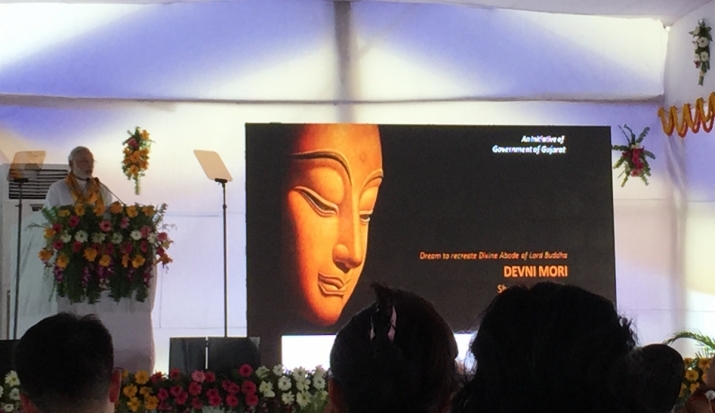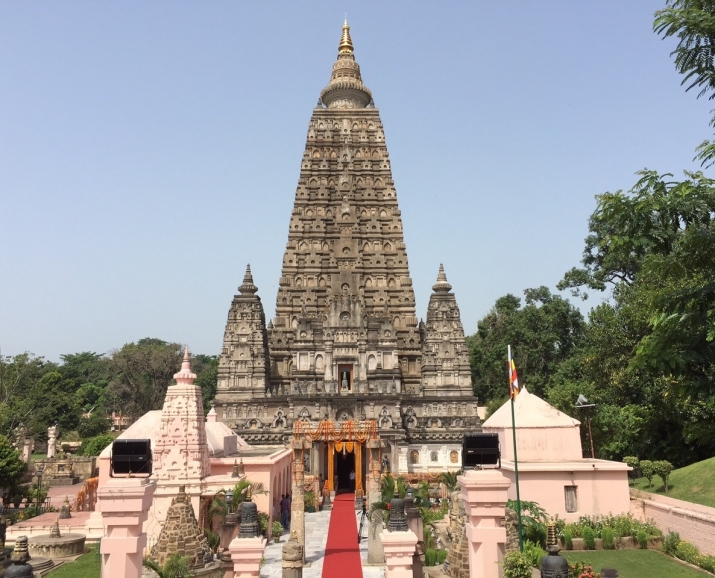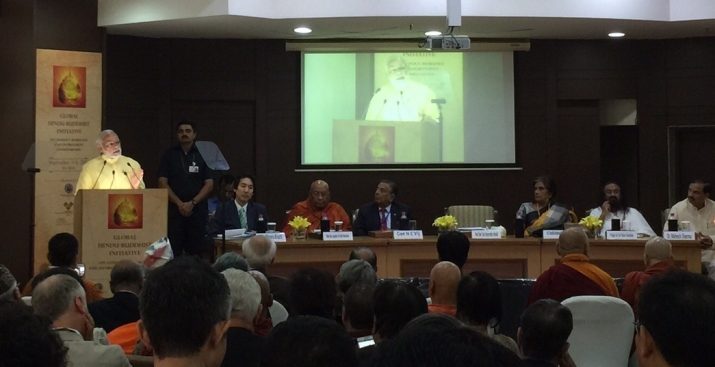FEATURES|THEMES|Commentary
Thoughts on the Global Hindu-Buddhist Initiative in Delhi, 3–4 September 2015
 India’s prime minister, Narendra Modi, addresses guests and dignitaries in Bodh Gaya on 5 September.
India’s prime minister, Narendra Modi, addresses guests and dignitaries in Bodh Gaya on 5 September.Buddhistdoor Global has watched and covered the activities of the International Buddhist Confederation (IBC) since 2011. It is not well known in the West, but it is in reality one of Asia’s most important Buddhist networks (or, put more crudely, power brokers). The recent conference “Samvad—A Global Hindu-Buddhist Initiative,” co-organized by the Vivekananda International Foundation, the Tokyo Foundation, and the IBC, was intended to mark what many in the IBC hoped will be a milestone. Eminent guests included important Hindu swamis and Asian politicians and policymakers, such as Mrs. Chandrika Bhandaranaike Kumaratunga, the former president of Sri Lanka, and the Bhutanese minister of finance, Lyonpo Namgay Dorji. Many of the most senior Buddhist monastics from around Asia were represented as well.
On paper, the aforementioned milestone was supposed to signal the beginning of a productive Hindu-Buddhist dialogue on “conflict avoidance” and “environment consciousness.” As such, most observers would have expected the conference to bring together Hindus and Buddhists in a free, vigorous exchange about differing philosophical perspectives on peace mediation, statecraft, Indian geopolitics, and global environmental policies and responses to climate change, species extinction, and other urgent priorities; however, these stated objectives were only partially met. Barring the fact that the speakers had just 15 minutes each over the course of only two days, many of the Hindu and Buddhist masters spoke in generalities. Many of them had, perhaps understandably, little knowledge of the specifics of peacemaking or environmental issues, much less the time to explore them. Among the numerous treasured catchphrases used by various speakers were “from conflict resolution to conflict dissolution” and “a paradigm shift from the present conflict-resolution model powered by geopolitics to conflict-avoidance model (sic) inspired by civilization” (the latter appears on the Bodh Gaya Declaration that was drafted after the conference), but there was no explanation of the complexities such difficult goals would entail.
 The Mahabodhi Temple in Bodh Gaya was emptied of visitors for the event.
The Mahabodhi Temple in Bodh Gaya was emptied of visitors for the event.There were other curious issues. The Buddhist delegates invited by the IBC (including Buddhistdoor Global) far outnumbered the Hindu delegates from the Vivekananda International Foundation (VIF). The VIF is staffed by many senior ex-military commanders. Its director is General Nirmal Chander Vij, who served as India’s highest-ranking army officer (chief of the army staff) from 2003–5. Female Buddhist leaders were completely absent except for Jetsunma Tenzin Palmo. The presence of the Tokyo Foundation, a think tank that publishes on a broad spectrum of topics ranging from defense and diplomacy to domestic Japanese issues and Japanese finance, was also awkward. It inserted what seemed to be a third wheel of Japanese diplomats and opinion-makers (including Minoru Kiuchi, state minister for foreign affairs, who gave a speech, and defense and finance scholar Akiyama Masahiro, who set up the Tokyo Foundation) into the dialogue.
This triple entente of organizers—the IBC, VIF, and Tokyo Foundation—seemed to me quite the mismatch. Everything, however, fell into place once India’s prime minister, Narendra Modi, made his entrance for the chief address and his Japanese counterpart, Shinzo Abe, gave a message via recorded video.
Despite its various quirks, the conference was not a failure—it was actually a major success. The much-vaunted milestone was in fact never about breakthroughs on conflict avoidance or environment consciousness, or Hindu-Buddhist ecumenical insights. It was about the formal entrance of Modi, and by extension many of his supporters in Indian government, business, and philanthropy, into the contentious fray of religious diplomacy. On the Indo-Japanese diplomatic front, Abe and Modi lauded the Buddhist commonalities of the Indian and Japanese cultures (neither mentioned Modi’s recent visit to China). “Buddhism has played a significant role in forming the ideological foundation of Japan,” declared Abe, suggesting that Buddhism was one of the origins of the “rule of law,” on which the nation placed great value, and relating it to the “Dharma of Indian philosophy.”
If Buddhist representatives were delighted by Modi’s preliminary courting, the real red meat came on 5 September, when he appropriated the symbolism of Buddhism into his diplomatic repertoire at the Mahabodhi Temple in Bodh Gaya. Arriving under tight security (the temple was closed to the public on the day), he sat under the Bodhi Tree and listened to chanting by monks representing the three Buddhist vehicles of Theravada, Mahayana, and Vajrayana. He then gave a speech to the conference delegates, proclaiming his admiration for the Buddha and plans to keep Bodh Gaya at the center of the Buddhist orbit, rather than ceding it to potential competitors like Lumbini in Nepal or elsewhere. “We would like to develop Bodh Gaya so that it becomes the spiritual capital and civilizational bond between India and the Buddhist world,” he declared to applause. At Bodh Gaya, he was shrewdly presenting his personal identity to a mainly Buddhist audience as an Indian “defender of the faith.”
 Modi gives his address. Seated from left: Minoru Kiuchi, Sayadaw Ashin Nyanissara, Gen. Nirmal Chander Vij, Chandrika Bhandaranaike Kumaratunga, Sri Sri Ravi Shankar, and Mahesh Sharma.
Modi gives his address. Seated from left: Minoru Kiuchi, Sayadaw Ashin Nyanissara, Gen. Nirmal Chander Vij, Chandrika Bhandaranaike Kumaratunga, Sri Sri Ravi Shankar, and Mahesh Sharma.Modi’s previous gestures of support for Buddhism had been made in the context of larger events, like making official the annual celebration of Vesak in May or his trip to China the same month, where he visited historic temples of Sino-Indian exchange. This conference was his platform to create his own context. As such, it was the most openly political Buddhist conference that I have attended so far. This is not necessarily a bad thing, as politics is part and parcel of civilization and driven politicians can also do great things for Buddhism, regardless of the question of pure intention. For all his problems, Modi has the potential to be one such politician. Perhaps, in the future, there should be a conference specifically to engage politicians and opinion-makers on the suitability of Buddhism as a nation-building component in Indian statecraft.
A longer-term difficulty relates not to politics, but to philosophy. There was no mention of the fundamental differences between Buddhism and Hinduism: mainly, the question of atman and anatman (Self and non-Self) and the conception of the Buddha as an avatar of Vishnu come to lead the deluded away from Hinduism. This was perhaps the most troubling theme of the conference: it relied on outdated modes of interfaith dialogue that focus on ethics and doctrines that are similar, while avoiding the big disagreements concerning the fundamental world views of the religions in dialogue.
Although this approach is intuitively attractive (and helps us avoid awkward conversations over dinner), theologians have in recent years come to recognize its limitations, with many appreciating the need to discuss thoroughly our major philosophical differences. True harmony and acceptance are found not only in the active embrace of difference, but also in reflection on the religious significance of such differences. For our part, Buddhists need to think humbly about what the existence of Hinduism in the world (and its ideological and political thumping of Buddhism in South Asia during the medieval period) has meant and continues to mean for our engagement with Indian culture and civilization. The answers were never going to be found in a two-day conference. What this initiative has done, however, is give us fresh impetus to figure out something decisive, even as Modi raises the stakes in his Buddhist diplomacy game.














